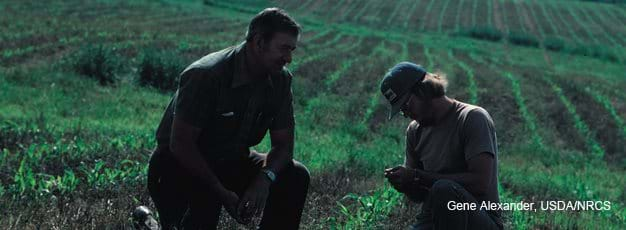Mitigating Climate Change: Opportunities for Farmers

Stemming climate change is a major global concern. The policy option currently under consideration to address this problem is a nationwide “Cap-and-Trade” system that would cap the amount of greenhouse gas (GHG) emissions from industrial sources. Under this system, industrial sources of greenhouse gases would be required to have a permit, or “allowance,” for every ton of their emissions, and the total number of allowances made available would be equal to the legislated cap.
Agriculture would not be required to have these permits under most Cap-and-Trade proposals. Instead, climate-friendly agricultural activities could be made eligible for “offset credits” that an industrial source can purchase and submit in place of the required emission permits.
Farmers who adopt practices such as no-till, nitrogen inhibitors, improved manure management, or tree planting could potentially be eligible to receive sellable offset credits. Agricultural offset sales to industries could provide an additional source of revenue for the farm, while also reducing the total cost to the economy of meeting the GHG cap.
Independent estimates by the U.S. Environmental Protection Agency and the Energy Information Agency suggest that the market price of GHG emission allowances might be as low as $13 per ton or as high as $60 per ton of carbon dioxide in 2015, depending on policy design and assumptions about the availability of alternative technologies.
ERS calculates that, if the market price for offsets was $13 per ton, a Corn Belt farmer switching from conventional tillage to no-till might receive $8 per acre per year in offset credits, based on estimates of the carbon sequestration of no-till in that region. The farmer would need to weigh this new revenue against possible effects of no-till on yield or costs and against other possible restrictions, such as a requirement that the no-till be permanent. Converting cropland to trees could earn that same farmer $60 per acre per year because trees provide greater greenhouse gas benefits, but this activity would come at the cost of lost revenues from crop production. Farmers in the Delta States would likely receive more offsets for these activities, and therefore earn greater revenue, because their growing conditions are more favorable to carbon storage.
As offset prices increase, so would potential revenues. At $60 per ton, Corn Belt farmers could receive $38 per acre annually for no-till and $280 per acre for tree planting.
Although offset markets represent a potentially large new source of income for farmers, a myriad of details will drive farmer decisions about what kinds of offset activities might be most profitable, if any. These details include the types of eligible practices, baseline activity levels (below which credits would not be issued), rules for measuring and verifying offsets, and liability rules in case of reversals away from the carbon-conserving practices.
Climate Change, by Ron Sands, USDA, Economic Research Service, October 2024
Economics of Sequestering Carbon in the U.S. Agricultural Sector, by Jan Lewandrowski, Mark Peters, Carol Jones, Robert House , Mark Sperow, Marlen Eve, and Keith Paustian , USDA, Economic Research Service, March 2004


